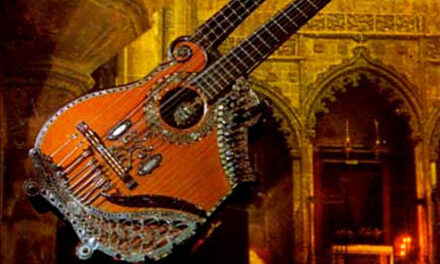
We now pause for this commercial break.
The brand new edition (actually, an entirely new book) of The Lute in Europe that I blogged about last December is finally available.
By a curious series of events, I find myself the U.S. outlet for retail sales (go figure – as I am not remotely involved in the lute community). So here is where any interested U.S. customers can purchase it. At the moment, I’ve only a few copies left (comps and pre-orders used up the first 100-pound shipment). I’ll get more, so don’t panic – they’ll just take a while to get here.
Considering that this is a limited run labor of love by the authors (Andreas Schlegel & Joachim Lüdtke), then add in the sucky Dollar/Euro exchange rate and the expense to get these here from Germany (they are heavy!), the price seems quite a deal for a full-color book an inch and a half thick.
The authors are serious lute scholars: history, musicology, terminology, stringing, tuning, etc. – there is a lot here. Some detailed topics may appear a bit complex to the non-lutenist (that would be me), as do many of the superficially similar instruments (or dissimilar: a mandora is not a mandore, it turns out…). I was glad to learn how and why my “German theorbo” should really be labeled a “swan-necked Baroque lute.” Actually, my main complaint is that the book should have been five inches thick, as I know there is a ton of additional explanatory detail and examples (and instruments) they could have thrown at us. But what a great start! They cover not only all the lutes, but precursors, relatives, and other contemporaneous plucked strings, especially the cittern family. They touch on mandolins and guitars, though sadly ignore harp guitars almost entirely (ironically, the sole image I donated was of my Gibson mandolin orchestra set). Still, plenty of floating strings relatives are covered, with short sections on the Swedish lute, torban, plus theorboed guitar-lutes, arch-citterns, and of course, a multitude of different lute forms with floating basses.
One interesting layout feature: 150 of the right-hand pages sequentially arrange high-quality photographs of plucked stringed instruments (and the occasional manuscript) in roughly chronological order from medieval times to the present. I got over my initial confusion once I realized that various photos may be referenced from elsewhere in the book (and by their facing page number, as the full-bleed images are not page numbered, but dated). What a trove of previously unpublished specimens from museums and private collections from all over the world!
All text is in both German and English. The translation is excellent (except for that occasional pesky “und” that Joachim seems to keep missing).
All in all, a must-have for plucked stringed instrument scholars and laypeople alike.
Operators standing by (unless I’m in bed, at work, in the studio, or otherwise pre-occupied…).





